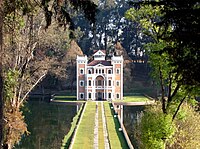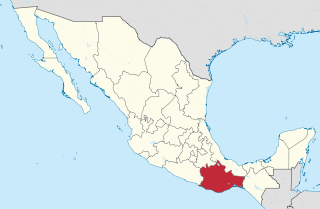
Oaxaca, officially the Free and Sovereign State of Oaxaca, is one of the 32 states that compose the Federative Entities of the United Mexican States. It is divided into 570 municipalities, of which 418 are governed by the system of usos y costumbres with recognized local forms of self-governance. Its capital city is Oaxaca de Juárez.
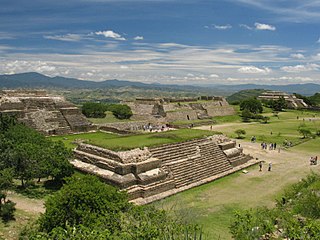
Oaxaca de Juárez, or simply Oaxaca, is the capital and largest city of the eponymous Mexican state of Oaxaca. It is the municipal seat for the surrounding municipality of Oaxaca. It is in the Centro District in the Central Valleys region of the state, in the foothills of the Sierra Madre at the base of the Cerro del Fortín, extending to the banks of the Atoyac River.

Amecameca is a municipality located in the eastern panhandle of Mexico State between Mexico City and the Iztaccíhuatl and Popocatépetl volcanos of the Sierra Nevada mountain range. It is located on federal highway 115 which leads to Cuautla, which is called the Volcano Route.

Puebla, officially Free and Sovereign State of Puebla, is one of the 32 states which comprise the Federal Entities of Mexico. It is divided into 217 municipalities and its capital is the city of Puebla.
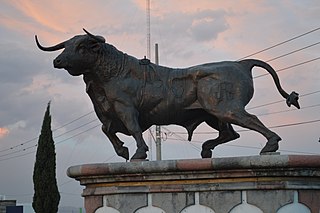
Huamantla is a small city in the municipality of the same name in the eastern half of the Mexican state of Tlaxcala. The area has a long indigenous history, but the city itself was not founded until the early colonial period, in the 1530s. It is mostly agricultural but it is best known for its annual homage to an image of the Virgin Mary called Our Lady of Charity. This includes a month of festivities, the best known of which are the “night no one sleeps” when residents create six km of “carpets” on the streets made from colored sawdust, flowers and other materials. The other is the “Huamantlada” a running of the bulls similar to that in Pamplona.

The Archdiocese of Antequera, Oaxaca is a Latin Church ecclesiastical territory or archdiocese of the Catholic Church in Mexico. The cathedral church is the Cathedral of Our Lady of the Assumption in the episcopal see of Oaxaca. It was erected on June 21, 1535.

Colonia Santa María la Ribera is a colonia located in the Cuauhtémoc borough of Mexico City, just west of the historic center. It was created in the late 19th century for the affluent who wanted homes outside of the city limits. The colonia reached its height between 1910 and 1930. In the 1930s, the middle class moved in and a new era of construction began. The colonia began to deteriorate in the 1950s, as the city grew around it and apartment buildings were constructed. Since the 1985 Mexico City earthquake, poorer residents have moved in and economic housing has been constructed. Today, the colonia is a mix of old mansions and homes, small shops and businesses, tenements and abandoned buildings. The colonia has one major park and two museums. This area was designated as a "Barrio Mágico" by the city in 2011.
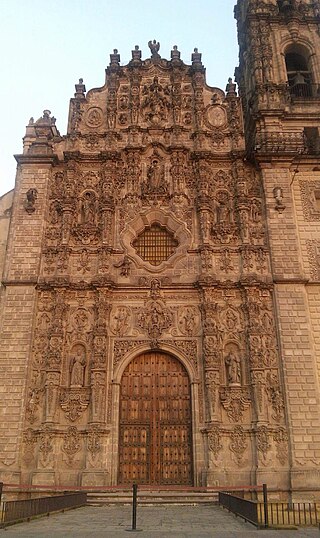
Tepotzotlán is a city and a municipality in the Mexican state of Mexico. It is located 40 km (25 mi) northeast of Mexico City about a 45-minute drive along the Mexico City-Querétaro at marker number 41. In Aztec times, the area was the center of a dominion that negotiated to keep most of its independence in return with being allied with the Aztec Triple Alliance. Later, it would also be part of a "Republic of the Indians," allowing for some autonomy under Spanish rule as well. The town became a major educational center during the colonial period when the Jesuits established the College of San Francisco Javier. The college complex that grew from its beginnings in 1580 would remain an educational center until 1914. Today this complex houses the Museo del Virreinato, with one of the largest collections of art and other objects from this time period.

The Marquessate of the Valley of Oaxaca is a hereditary marquessal title in the Spanish nobility and a former seignorial estate in New Spain. It was granted to Don Hernán Cortés, conquistador who led the conquest of the Aztec Empire, by Charles V, Holy Roman Emperor in 1529. Despite its name, the marquessate covered a much larger area than the Oaxaca Valley, comprising a vast stretch of land in the present-day Mexican states of Oaxaca, Morelos, Veracruz, Michoacán and Mexico.

Huasca de Ocampo is a town and municipality of the state of Hidalgo in central Mexico. It is located 34 km from Pachuca and 16 km from Real del Monte in the Pachuca Mountains. While the town itself is just within the mountain range, much of the municipal land is located in a valley that opens up to the east of the town. While one of the first haciendas to be established in Mexico is located here, economic development started with mining haciendas built by Pedro Romero de Terreros in the 18th century. By the mid 20th century, none of these haciendas were in existence, having been broken up into communal farm lands and some even fully or partially under lakes created by dams. While agriculture remains important economically, the area has been promoted as a tourism destination, especially for weekend visitors from Mexico City, with attractions such as canyons, traditional houses, old hacienda facilities and waterfalls.
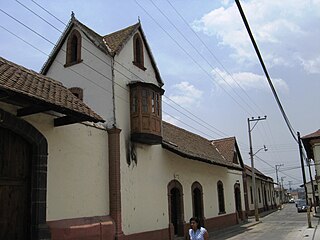
Ayapango is one of 125 municipalities located in the southeast portion of the State of Mexico, southeast of Mexico City. It's municipal seat and largest town is Ayapango de Gabriel Ramos Millán. Despite the fact that this municipality is distinctly rural, it falls within the Mexico City Metropolitan Area. The town is known for its "French style" houses built early in the last century which have names which reflect something of their characteristics. The name Ayapango is derived from "eyapanco" which roughly translates to "place where three irrigation ditches meet." This town has been designated as a "Pueblo con Encanto" by the government of the State of Mexico.

San Salvador el Verde (municipality) is a town and municipality in the Mexican state of Puebla in south-eastern Mexico. It is best known as the site of the Chautla Hacienda, which was the property of Eulogio Gillow, the first archbishop of Antequera (city of Oaxaca) and contains an English style residence called locally called "El Castillo" (The Castle). The facility today is run as a recreation center.

The Cathedral of Our Lady of the Assumption, located in the city of Oaxaca de Juarez, Oaxaca, Mexico, is the seat of the Roman Catholic Archdiocese of Antequera, Oaxaca. Its construction began circa 1535 and it was consecrated on 12 July 1733. It is dedicated to Our Lady of the Assumption.
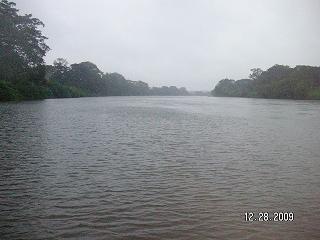
El Corte River is the primary tributary of the Coatzacoalcos River, flowing through the Mexican states of Oaxaca and Veracruz to the Gulf of Mexico.

Juchitán District is located in the east of the Istmo de Tehuantepec region of the State of Oaxaca, Mexico, covering the southern part of a low-lying corridor through the mountains that separates the Gulf of Mexico from the Pacific ocean. The district has an area of 13,300 km2 and a population as of 2005 of 339,445.
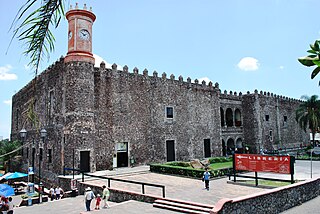
The Palace of Cortés in Cuernavaca, Mexico, built between 1523 and 1528, is the oldest conserved virreinal-era civil structure in the continental Americas. The architecture is a blend between Gothic and Mudéjar, typical of the early 16th century colonial architecture. The building began as a fortified residence for conqueror Hernán Cortés and his aristocratic second wife, Doña Juana Zúñiga. It was built in 1526, over a Tlahuica Aztec tribute collection center, which was destroyed by the Spanish during the Conquest. Cortés replaced it with a personal residence to assert authority over the newly conquered peoples. As Cortés's residence, it reached its height in the 1530s, but the family eventually abandoned it due to on-going legal troubles. In the 18th century, virreinal authorities had the structure renovated and used it as a barracks and jail. During the Mexican War of Independence, it held prisoners such as José María Morelos y Pavón. After the war, it became the seat of government for the state of Morelos until the late 20th century, when the state government moved out and the structure was renovated and converted into the Museo Regional Cuauhnahuac, or regional museum, with exhibited on the history of Morelos.
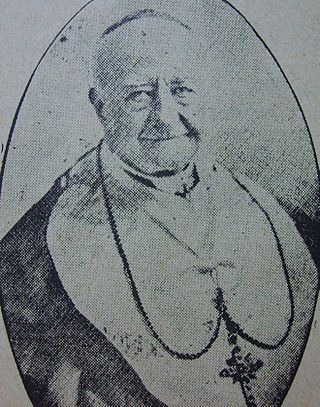
Eulogio Gregorio Clemente Gillow y Zavala was the first archbishop of the Roman Catholic Archdiocese of Antequera, Oaxaca located in Oaxaca de Juarez, Oaxaca, Mexico. He was the key cleric in President Porfirio Díaz's policy of conciliation with the Roman

The Piedras Encimadas Valley is a series of small valleys and tourist attraction located in the Zacatlán municipality of Puebla in central Mexico. The main feature of the zone is basalt rock formations in capricious forms, created by erosion over millions of years. The valley has been defined as covering anywhere from 100 to 400 hectares, most of which is privately owned land developed for tourism.
Taxco el Viejo is a town in the Mexican state of Guerrero. In 2010, it had a population of 3,172. It is located approximately ten kilometers south of the city of Taxco.
